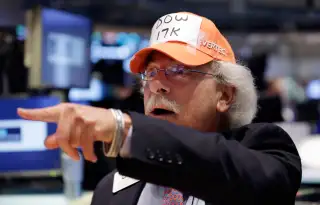3 Reasons to Care That the Dow Just Hit 17,000

What's the significance of the Dow Jones industrial average hitting 17,000 — as it did Thursday morning, shortly after the government reported that job creation in June was stronger than expected and that the unemployment rate is down to 6.1%?
Well, truth be told, it's not that big a deal -- but it does show...
... just how far this bull market has come. When this rally began in March 2009, the Dow was more than 10,000 points below where it stands today.
… just how fast this bull is moving. It took less than four months for the Dow to go from 16,000 to 17,000.
… and that Jeremy Siegel was right. In 2012, at a time when the Dow was still below 13,000, he predicted that the world's most-famous stock market benchmark would get to 17,000 by the start of this year. So he was only off by about six months.
The University of Pennsylvania finance professor — who gained fame with his 1994 book Stocks for the Long Run, the "bull market bible" — has long been viewed as Wall Street's eternal optimist. But being called a perma-bull by a bunch of business journalists isn't exactly a compliment.
What can you expect? As a group, journalists are far more likely to be pessimistic than optimistic. And we try to be as contrarian as possible. Hence, when it comes to stocks, which over time are likely to rise more often than they fall, we tend to lean toward predictions of doom and gloom over blue skies ahead.
This may help explain why Siegel has been unfairly lumped in with authors who unwisely made such famous predictions as Dow 36,000, Dow 40,000, and Dow 100,000.
And this is why journalists have tended to favor the opinions of Siegel's colleague and long-time friend, Yale economist Robert Shiller.
Shiller, who recently won the Nobel Prize, has gotten plenty of credit for having predicted the bursting of the tech bubble in 2000. It didn't hurt that his book, Irrational Exuberance, came out in March 2000, which was exactly the start of the bear market that sent equities into a "lost decade" that lasted until March 2009.
It should be noted, however, that back in 2012 — when a key gauge of market valuations popularized by Robert Shiller was flashing a bearish warning sign — Siegel publicly predicted that stocks would keep climbing higher.
He based this on the belief that in a low-interest rate environment, stocks should trade at a price/earnings ratio of around 18, based on future estimated corporate profits. And that's how he came to the 17,000 figure. (By contrast, Shiller prefers to value the market based on actual "normalized" or averaged earnings over the past 10 years.)
Of course, some market observers now believe that with the labor market strengthening, the Federal Reserve may have to start raising interest rates sooner than expected to stay ahead of inflation. And that could mean that stocks aren't assured of staying above the 17,000 threshold.
Nevertheless, this doesn't take away the fact that in an April 2012 interview with CNBC, Siegel said there was a 75% chance that the Dow would close 2013 above 15,000, and the odds were 50-50 of getting to 17,000.
A few months later, he went back on CNBC and reiterated his predictions. This time, he offered his assessment of the risks in the market.
“There are two major factors that are depressing our market 1,000 to 1,500 points,” he said on air. The first, he said was the fiscal cliff negotiations taking place in Washington, which had the potential to send the economy back into recession. The second was that monetary policy needed to become more aggressive and creative. This was before the Federal Reserve launched the most recent round of so-called quantitative easing.
After the fiscal cliff was avoided and the Fed got more creative with its stimulative bond-buying program, the markets really took off. In fact, here's how the Dow has performed since the Fed began its third round of quantitative easing on Sept. 12, 2012:
Soon after, he set 17,000 as his actual price target for the Dow by the end of 2013.
Today, based on modest earnings growth for U.S. corporations, Siegel says the Dow is likely to get to 18,000 sometime in 2014.
Of course, that's not such a bold forecast when you consider that going from Dow 17,000 to 18,000 represents less than a 6% jump in prices.
Still, it doesn't negate the fact that calling Dow 17,000 two years ago — when Europe was mired in a debt crisis, Washington was threatening to go off the fiscal cliff, and the Shiller P/E was flashing a warning — was pretty daring.